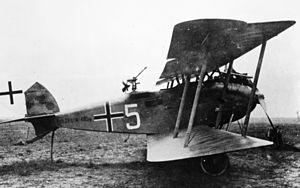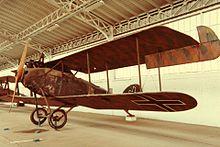| C.V | |
|---|---|
 | |
| a Halberstadt C.V (Side view) | |
| Role | Reconnaissance |
| Manufacturer | Halberstädter Flugzeugwerke |
| First flight | March 1918 |
| Introduction | June 1918 |
| Primary user | Luftstreitkräfte |
| Developed from | Halberstadt C.III |
The Halberstadt C.V was a German single-engined reconnaissance biplane of World War I, built by Halberstädter Flugzeugwerke. Derived from the Halberstadt C.III, with a more powerful supercharged 160 kW (220 hp) Benz Bz.IVü engine, it saw service only in the final months of the war. Cameras were mounted in the observer's cockpit floor.
The aircraft had very good flight characteristics, especially manoeuvrability and rate of climb, and was among best German World War I aircraft in its class.[1] First aircraft appeared in front in late June 1918.[1]
Operators
- Estonian Air Force - Postwar.
- Luftstreitkrafte
- Latvian Air Force - Postwar.
- Lithuanian Air Force - Postwar, 10 aircraft, used in 1919-1923.[2]
- Polish Air Force - 11 aircraft, used during Polish-Soviet War in 1919-1920[3]
 Soviet Union
Soviet Union
- Soviet Air Force - Postwar.
 Switzerland
Switzerland
Survivors
A single C.V (S/No. 3471/18) survives at the Musée Royal de l'Armée et d'Histoire Militaire in Brussels, Belgium.
Specifications (C.V)
Data from German Aircraft of the First World War[4]
General characteristics
- Crew: 2
- Length: 6.92 m (22 ft 8 in)
- Wingspan: 13.62 m (44 ft 8 in)
- Height: 3.36 m (11 ft 0 in)
- Wing area: 43 m2 (460 sq ft)
- Empty weight: 930 kg (2,050 lb)
- Gross weight: 1,635 kg (3,605 lb)
- Powerplant: 1 × Benz Bz.IVü 6-cyl. water-cooled in-line piston engine, 160 kW (220 hp)
Performance
- Maximum speed: 170 km/h (110 mph, 92 kn)
- Endurance: 3½ hours
- Service ceiling: 5,000 m (16,000 ft)
- Rate of climb: 10.42 m/s (2,051 ft/min)
- Time to altitude: ** 2,000 m (6,562 ft) in 3 minutes 12 seconds
- 5,000 m (16,404 ft) in 23 minutes
Armament
- Guns: * 1x 7.92 mm (0.312 in) LMG 08/15 Spandau machine gun mounted in the forward fuselage port side
- 1x 7.92 mm (0.312 in) Parabellum machine gun on a flexible mounting in the rear cockpit
- up to 50 kg of bombs[1]
See also
Related lists
References
- ^ a b c Peter M. Grosz: Halberstadt C.V, Windsock Datafile no. 69, Albatros Productions, 1998, ISBN 978-1-902207-02-5, p.1, 4, 6, 10
- ^ G. Ramoška, Pirmieji karo aviacijos lėktuvai 1919-23 m., http://www.plienosparnai.lt/page.php?81
- ^ Morgała, Andrzej (1997). Samoloty wojskowe w Polsce 1918-1924. Warsaw: Lampart. ISBN 83-86776-34-X, p.79 (in Polish)
- ^ Gray, Peter; Owen Thetford (1970). German Aircraft of the First World War (2nd ed.). London: Putnam & Company Ltd. pp. 143–145.
Bibliography
- Gerdessen, Frederik. "Estonian Air Power 1918 – 1945". Air Enthusiast, No. 18, April – July 1982. pp. 61–76. ISSN 0143-5450.

